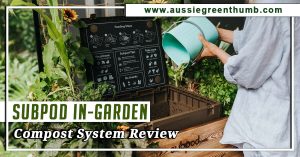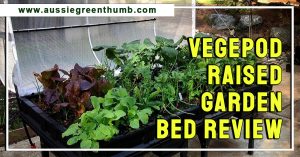While weeds serve an important purpose in the grand scheme of life and nature, there is a time and place to support them. Our cultivated vegetable beds are not that place, so in this article, we’re going to share our top picks of the best cultivators you can buy in 2024 for domestic gardens, private veggie plots and even smallholdings.
Cultivators help keep on top of soil aeration, reduce weeds when used properly, and make gardening on a big scale a lot easier.
More...
Cultivator and Tiller Top Pick for 2024

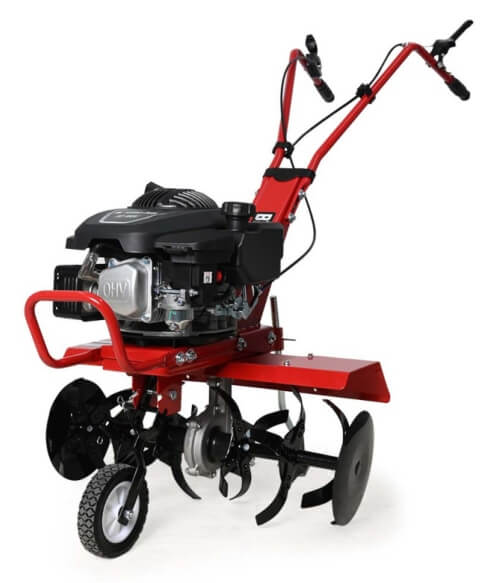
Cultivator and Rototiller Ratings Chart
Product | Our Rating | Price | |
|---|---|---|---|
1. Baumr-AG 150cc 4-Stroke Petrol Tiller Cultivator | 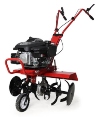 |  | |
2. GIANTZ 88cc Garden Tiller Cultivator | 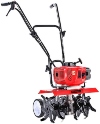 | ||
3. PlantCraft Titan 9 15" 4-Stroke Petrol Cultivator Tiller |  | ||
4. Greenworks 10-Inch 40V Cordless Cultivator | 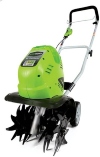 | ||
5. AAVIX 32cm 1250w Electric Cultivator Tiller |  | ||
6. Fiskars 40 to 60-Inch Telescoping Rotary Cultivator | |||
7. Hachiemon Garden Hand Tool Hoe and Cultivator |  |
What is a Cultivator?
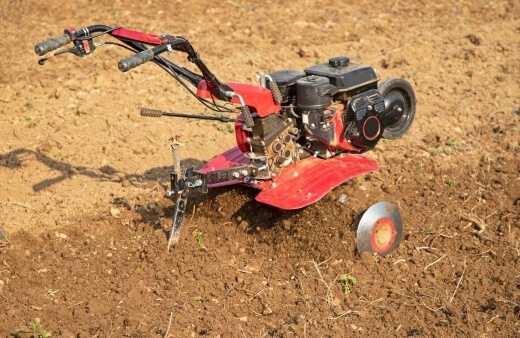
Cultivators are rotating hoes that help us till the soil. There are plenty of hand tools that do the same job as electric cultivators, but by and large, they are slow, and cumbersome alternatives.
The purpose of a cultivator is to dig through the soil, helping oxygen get deep down, improve drainage, and break up tough weeds.
When to Use a Cultivator
Cultivators are best used in late winter or early spring before the growing season begins, allowing weed-free plots to be dug over quickly, loosening up soil structure to make it easier to plant, and easier to maintain self-seeding weeds throughout spring and summer.
Do cultivators beat weeds?
It’s important to start with one very, very important point that is often used to justify harsh cultivation; cultivation does not reduce weeds. Cultivation can be an important part of a weed beating plan, but by itself, it will not get rid of weeds, and if done at the wrong time can in fact make the problem worse.
Most cultivators work by digging up and breaking down soil down to around 12-15 cm deep. Almost all perennial weeds can germinate and regrow from weeds roots that are 15-20cm deep, and cultivated soil is actually easier for them to break through.
To cultivate soil as a weed control measure, it needs to be done every few days in the high heat of summer. The roots can dry out on the soil surface. Cultivating in spring will increase weeds, and cultivating in winter is essential just creating root cuttings!
Different Types of Cultivators
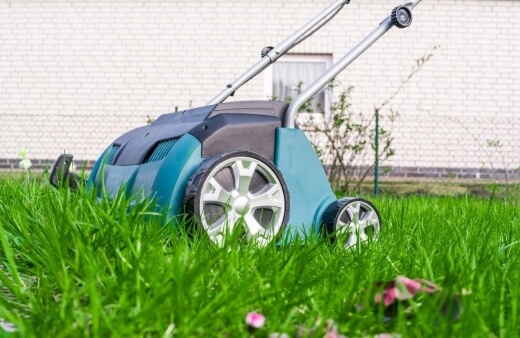
Cultivation is one of those words in gardening that means many different things at once, but fundamentally, it’s the term given for treating and managing the earth.
Cultivation tools are designed to dig up and scarify soil, which helps to aerate and remove shallow-rooted weeds.
There are a few different ways we do that in horticulture, and depending on the depth you need to cultivate to there are three different tools:
- Tillers
- Cultivators
- Scarifiers
Each can be done either with hand tools, or power tools, but all achieve similar results with differing severity.
Tillers, Cultivators and Scarifiers: What’s the Difference?
Tillers are the most severe form of cultivation. By churning up soil down to a depth of around 25cm they remove most deep-rooted weeds and are an excellent way to prepare the earth for planting in spring.
While most tillers are not designed for use during the growing season, narrower types that fit between rows of vegetables are common in agriculture.
Cultivators are generally easier to use, and more available for domestic use, with cultivators sold at Edison’s, Bunnings, and all over amazon.
Because they are so widely available, most people automatically purchase cultivators where different cultivation tools, like scarifiers, might do the job better.
Most domestic cultivators are narrow and are predominantly designed to aerate the soil with rotating blades.
Scarifiers disturb the surface layer of soil and are great for reviving dead patches of lawn without completely tearing up the soil. Most cultivators are sold with interchangeable blades so they can be used for scarifying and cultivation.
Cultivator Safety Tips
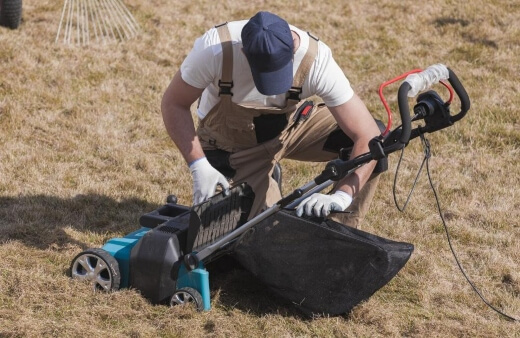
Cultivators are powerful tools with powerful blades. For obvious reasons you should never inspect the blades while they are attached to a power source if the engine is running.
Some less obvious safety tips for using cultivators are:
- Wear goggles. Objects can be flicked up by cultivators, even if they have safety guards.
- Always walk behind a cultivator.
- Apply pressure to avoid the machine bouncing.
- For corded cultivators, ensure the wire is trailing behind you at all times.
How to Use a Cultivator
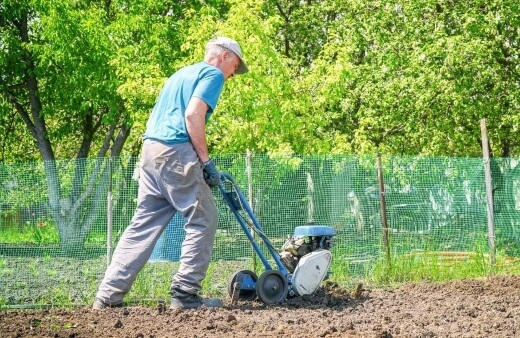
Using a cultivator, particularly a power cultivator, is very similar to mowing a lawn with a push mower. The only difference is that you’ll need to apply a little bit of downward pressure to get started.
Cultivators begin by spinning blades that tear open the surface soil, but without pressure, they simply bounce along.
- Start by moving any large stones or objects from the path of a cultivator
- If you are churning up whole patches of earth, cultivate a ring around the patch first, then move up and down in parallel lines to ensure full cultivation.
- For cultivating between rows of vegetables, move slowly and cultivate once a week during the growing season to keep on top of weeds.
One negative effect of cultivators is that they can just cut up weeds rather than kill them, which actually creates more weeds, rather than suppresses them. So repeating cultivation throughout the growing season for agricultural sites and veggie gardens is very necessary.
What to Look For When Buying a Cultivator
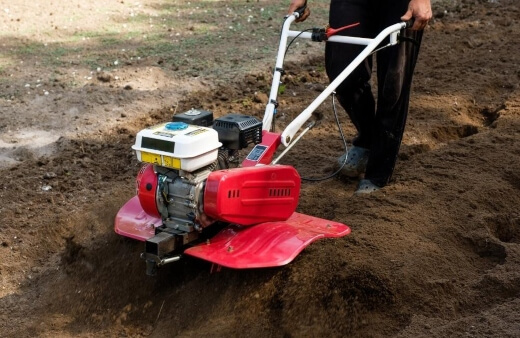
How wide should a cultivator be?
Cultivators tend to come at a width of 20-50cm. Anything bigger is designed for agricultural use rather than garden use, and anything smaller is really a hand cultivator.
The wider your cultivator, the faster it will work through your plot, but for smaller plots, narrow cultivators can be more practical choices and even be used for ongoing crop management throughout the year without damaging surrounding crops.
How deep should a cultivator be
Cultivators are designed to aerate soil. That’s the principle purpose, so if you consider that most vegetable crops grow to depths of 12-15cm, that’s more than enough depth for a standard cultivator.
The other reason people ask this question though is because they expect their cultivator to tackle weeds. If you are buying a cultivator to tackle weeds, you need to buy one that can dig down to at least 20cm.
Anything less than that will allow established roots to reach the surface within a couple of weeks in spring.
How heavy should a cultivator be?
For most garden tools, it’s important to find tools that are easy to carry, and easy to store, but cultivators require a fair amount of pressure to cut into the soil and stay buried as they break down the soil surface, so lightweight cultivators can bounce and ricochet off stones, which is not just counterproductive, but dangerous.
Heavier cultivators might not seem attractive to most gardeners, but they are the safest and most efficient tools.
Cultivator's Power Source
Most cultivators are corded, making them convenient and environmentally friendly, but that does come with a big disadvantage of having a cord trailing around behind a machine designed to cut through anything it touches.
Petrol and diesel cultivators are convenient in that they don’t have wires, but they are heavy, and designed for agricultural spaces rather than domestic gardens or smallholdings.
Battery operated cultivators are the most practical choice, without burning fossil fuels, or dragging cords around the garden with you.
Best Cultivator and Rototiller Reviews
1. Baumr-AG BT-889 150cc 4-Stroke Petrol Tiller Cultivator

Baumr-AG BT-889
Cultivators are designed to power through the tough ground, break it up, and break down weed roots, so finding powerful models that can cope with agricultural land is always the measure of a good cultivator.
The Baumr-AG 4-stroke petrol rototiller is designed for tough ground, with a 13cm tilling depth that’s enough to get out almost all of the worst roots and bring them to the surface.
If you’re preparing the ground for new planting, this is a great way to dig down and is easily deep enough to start preparing potato rows.
For domestic gardens, this Baumr-0AG model might be overkill, but for large landscapes, shared plots, or smallholdings, you won’t find a better cultivator for sale.
Pros
Cons
2. GIANTZ ?GTC-ET-6B-OG 88cc Garden Tiller Cultivator
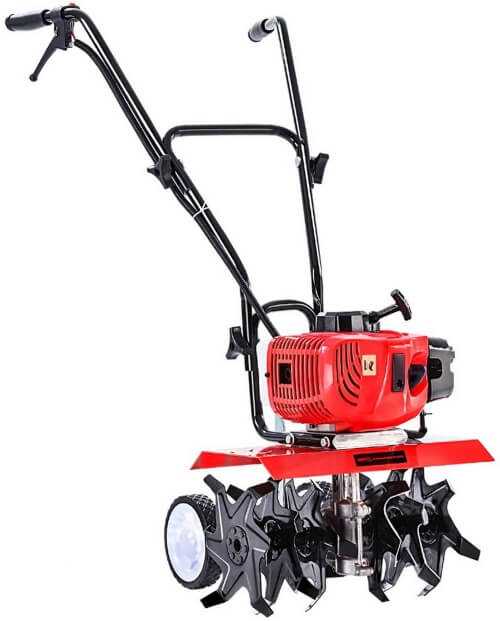
GIANTZ ?GTC-ET-6B-OG
For smallholdings and serious vegetable growers, the Giantz rotary cultivator has effective twists to its blades that hoe out weeds and leave them on the soil surface to dry out, so is perfect for those warm spring days before the soil is ready for planting, making light work of large areas of earth.
Considering that the most directly comparable rototiller you can buy is nearly twice the price, this is a great bargain, so grab one while you can if you’ve got land to manage.
The Giantz range always looks pretty clunky, but I actually find that reissuing, because they’ve not focussed on frilly designs, and instead work towards creating machines that can actually do the job they were designed to do.
Pros
Cons
3. PlantCraft Titan 9 15" 4-Stroke Petrol Cultivator Tiller

PlantCraft Titan 9
Plantcraft’s simple cultivator is one of the most affordable garden tillers on the market, and it’s really well built, especially when you consider the price.
They might not be a household name, but this is a stunningly useful garden tool that makes light work of any spring tilling, whether you’re working over garden beds, or cultivating your own smallholding.
Like any garden tiller, Plantcraft’s Titan 9 isn’t exactly going to cover a full farm, but it’s more than enough for domestic and hobby use, and does a really thorough job down to a surprisingly deep depth of 20 cm, while still offering full protections with a durable guard and well supported blades.
Pros
Cons
4. GreenWorks 10-Inch 40V Cordless Cultivator
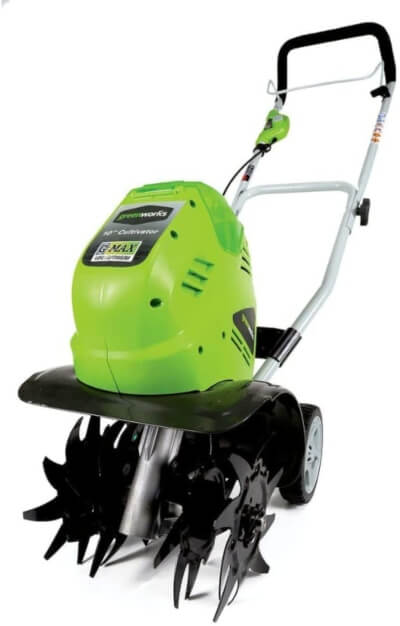
GreenWorks 27062A
The Greenworks 10-inch cordless cultivator is a great tool for home gardeners and commercial gardeners working on a small scale. The battery-operated cultivator makes light work of small spaces but is too narrow to be practical for large gardens.
At 2000 strikes per minute, the Greenworks cultivator is incredibly hard-working and can break through most soils no matter how compact they’ve become thanks to its sturdy blades.
Pros
Cons
5. AAVIX A21111 32cm 1250w Electric Cultivator Tiller
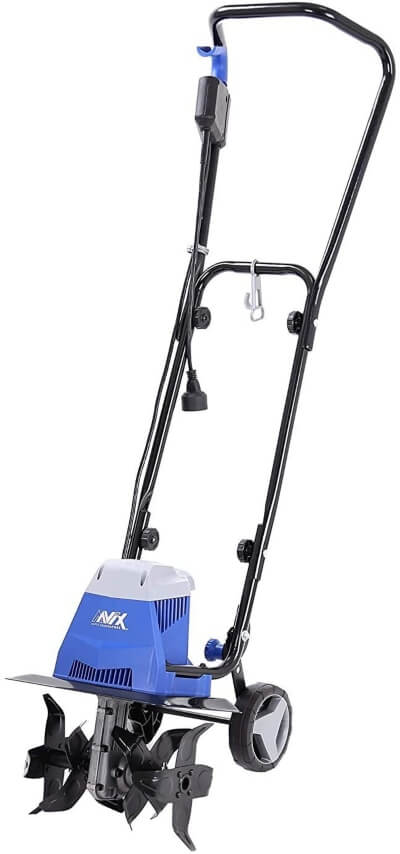
AAVIX A21111
Corded rototillers are usually a no from me because, of all garden tools that run the risk of catching their own wires, rototillers are the most dangerous tools to have a corded electric motor.
However, in its price range, this is the only rototiller that can cultivate down to 22cm deep. It’s only got a 32cm tilling width, but that’s forgivable thanks to the fact it’s only one of two cultivators on review here that gets deep enough to remove weed roots beyond light-blocking levels.
Pros
Cons
6. Fiskars 98966935 40 to 60-Inch Telescoping Rotary Cultivator

Fiskars 98966935
A brief confession before I start this review: I have one of these at home, and one at my allotment. I love it. I’m very biassed! For commercial cultivation, there is absolutely no way that a tool like the Fiskars rotary cultivator would be useful.
It’s useless over large areas, but the narrow head and lightweight design make it absolutely perfect for weeding between beds and aerating the soil between rows of potatoes.
For any serious gardener who loves growing their own fruits and vegetables at home, you’ll know the importance of convenience, and this is so much better than a conventional hoe.
I cannot rate this cultivator highly enough, and even though it’s not powered, takes a lot more work, and can’t manage large plots, it still gets a top score from me because there is no better cultivator for working small plots.
Pros
Cons
7. Hachiemon YAMOOCO Garden Hand Tool Hoe and Cultivator
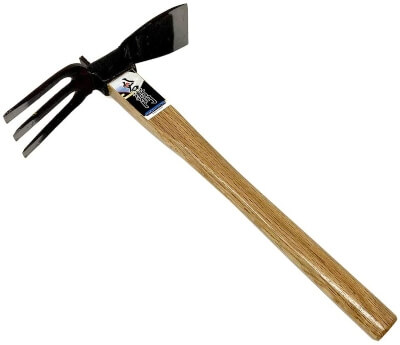
Hachiemon YAMOOCO
Once in a while, it’s worth putting your job into context. If you’re looking for a basic cultivator tool, for a small garden, or to help break up soil for veggie beds, then basic hand tools like this are perfect.
This traditional Japanese style garden hoe & cultivator by Hachiemon is well-made and if properly maintained can last a lifetime.
Obviously, it’s not designed to cultivate large areas of the garden, but for weeding, and preparing raised beds for planting it’s a convenient and comfortable tool.
Pros
Cons
Top Rated Cultivator for 2024


Baumr-AG BT-889
Baumr-AG always just slightly outdo everyone else. I think it’s an ego thing. But this cultivator is exceptionally powerful and very, very, well designed with a petrol engine that helps to weight down the cultivator tines and fold-out wheel that makes it really easy to wheel back to the garage.
Whether you’ve got a small agricultural space to manage, or you’re just a passionate gardener, you really wouldn’t regret buying this rototiller cultivator by Baumr.
Cultivator Frequently Asked Questions
What is better: a tiller or cultivator?
While most cultivators are sold as tillers and cultivators for domestic purposes, tillers dig much deeper and more efficiently, but do massive amounts of damage to soil, disturbing the worms and insects that have beneficial effects on your plants. For most gardens, a cultivator is more than enough.
What’s the difference between a rotavator and a cultivator?
Rotavators and Cultivators have similar effects, but rotavators are driven by wheels and drag tines or blades through the soil to churn it, while cultivators churn the soil and use no wheel to drive, meaning they can dig as deep as the blade goes.
Can a cultivator remove weeds?
Cultivators should never be used for weed management by themselves. They will pull out thick roots weeds and leave them on the soil surface, but for fibrous-rooted weeds, cultivators tend to tear their roots up and will actually create more weeds as a result.
See our list below for more tools buying guides to help you take care of your lawn:

Get the Best Cultivator for 2024
Cultivators are great tools for commercial farming, and smallholdings, but small scale cultivators are a great tool for allotment and vegetable gardens, so if you’re new to the world of mechanical gardening, I hope this article helped get you on the right track!
Choosing the best cultivators is probably easier than you think. It’s just a question of whether you want to aerate, weed, or just loosen soil between plants. Once you know what you plan to use your cultivator for it’s much easier to choose the best cultivator for you.
Published on October 18, 2023 by Gary Clarke
Last Updated on January 11, 2024


